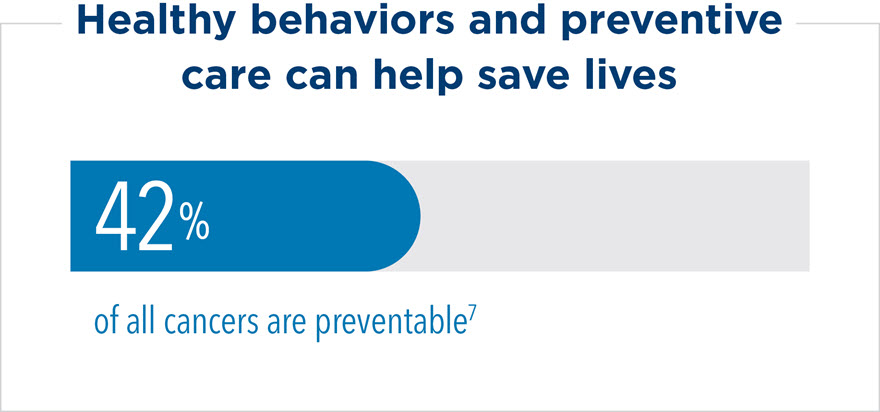The pandemic impacted the physical health of many Americans beyond COVID-19 infections. An estimated 9.4 million screenings for breast, colorectal, and prostate cancers were missed during the first half of 2020.1 And diagnoses of 8 types of cancer were down by 30% on average at the start of the pandemic, compared with 2019 and early 2020.2 Because of these delays in preventive care, advanced diagnoses of cancers like breast and colorectal are expected to increase.3 Such later-stage diagnoses can mean lower survival rates — and higher costs for care.4,5


You can help influence better health outcomes for your workforce in several ways.
- Offer a health plan that reminds your employees to get preventive care like cancer screenings, and has tools that encourage healthy behaviors, such as quitting smoking or staying active.
- Communicate to your employees the important role of cancer screenings in a healthy life.
- Share the recommended cancer screening guidelines with your workforce.
- Encourage cancer screenings by normalizing discussions around them and celebrating employees who get them.

At least 42% of newly diagnosed cancers in the U.S. are potentially avoidable. Along with getting recommended cancer screenings, your employees can make many lifestyle changes that may help prevent cancer — such as staying active, avoiding alcohol and tobacco, eating healthy, and using sunscreen.
How your employees can reduce their cancer risk
Talk with a doctor
It’s important for your employees to have a personal doctor — their partner in health. A doctor can guide them toward healthy habits, recommend screenings, connect them to specialists, and more. Employees should:
- Make an appointment — Getting in touch early and often can help them stay on top of their health.
- Build the relationship — They can help the doctor create a personalized cancer prevention plan by sharing their family’s cancer history and any symptoms they may be concerned about.
- Stay connected — They can reach out to the doctor with questions or to request follow-up care.

Get regular screenings
Many forms of cancer can be detected early, when it’s more treatable — leading to better outcomes. A doctor can make personalized recommendations for which preventive screenings are appropriate.
Types of screenings and when to screen
- Breast cancer — There are a few screening options, including mammograms. People who are high risk can start mammograms at age 40. By 50, mammograms should take place every 1 to 2 years.
- Colon cancer — Screenings can be in person with a colonoscopy or at home with a stool sample test. Most people who are low risk start getting screened at 50. People who are high risk due to family history may start screening earlier. The recommended screening age for Black Americans is 45. Colon cancer screenings are typically done every 10 years until you’re at least 75.
- Lung cancer — Screenings are done with CT scans, which use X-rays to make detailed pictures of structures inside the body. People who are 50 or older and have smoked 20 packs or more per year within the last 15 years should consider getting screened.
- Cervical cancer — Screenings are done with a Pap test or human papillomavirus (HPV) test. After age 21, doctors recommend screening every 3 to 5 years — or more often, depending on medical and screening history.
- Prostate cancer — Prostate-specific antigen (PSA) tests are blood tests that screen for prostate cancer, usually given to men who have no symptoms. A doctor can make a personalized recommendation on who should get screened. Due to higher risk, Black American men may start screening at 45.

Practice prevention
Screenings aren’t available for every type of cancer. However, there are still ways your employees can be aware of changes in their health.
Know the symptoms and signs
Some cancers give clues about what’s going on inside the body.
- Symptoms are what a person experiences physically or mentally. For example, bright red blood after a bowel movement can be from rectal bleeding — a common symptom of colorectal cancer.
- Signs are observable characteristics a doctor can identify. Early signs of skin cancer, for example, are changes in shape, color, or size of moles or lesions.
Many signs and symptoms are the same as other minor conditions. A doctor can recommend next steps.
Additional resources you may find helpful



1“Cancer Market Trends for 2022,” Advisory Board, April 2022.
2See note 1.
3See note 1.
4Nigel Hawkes, “Cancer Survival Data Emphasise Importance of Early Diagnosis,” The BMJ, January 25, 2019.
5Zura Kakushadze et al., “Estimating Cost Savings from Early Cancer Diagnosis,” Data, September 4, 2017.
6See note 1.
7“Cancer Facts & Figures,” American Cancer Society, 2022.
8See note 4.
Kaiser Permanente health plans around the country: Kaiser Foundation Health Plan, Inc., in Northern and Southern California and Hawaii • Kaiser Foundation Health Plan of Colorado • Kaiser Foundation Health Plan of Georgia, Inc., Nine Piedmont Center, 3495 Piedmont Road NE, Atlanta, GA 30305 • Kaiser Foundation Health Plan of the Mid-Atlantic States, Inc., in Maryland, Virginia, and Washington, D.C., 2101 E. Jefferson St., Rockville, MD 20852 • Kaiser Foundation Health Plan of the Northwest, 500 NE Multnomah St., Suite 100, Portland, OR 97232 • Kaiser Foundation Health Plan of Washington or Kaiser Foundation Health Plan of Washington Options, Inc., 1300 SW 27th St., Renton, WA 98057
Congratulations! You have successfully saved this item.
To access your Saved items any time, open the "Saved Items" folder in the top right corner of the page.
It seems that you do not have cookies enabled. Please enable cookies to make use of all of our site's functionality.
You haven't collected any items yet.
- Save Content
Click the "Save" icon next to the content you want to revisit later.
- Access Your Saved Items
Click on the "Saved Items" link at the top of the page or use the URL we create for you.
Be sure to copy and paste the URL we create for you before you leave the site.
1-5 of 14
Your Link
After leave the site, your saved items will be saved for you at this URL:
https://business.preview.dpaprod.kpwpce.kp-aws-cloud.org/saved-items?user=Share your list
Show Disclaimer +


